2017 Peugeot 3008 Hybrid 4 ABS
[x] Cancel search: ABSPage 209 of 566
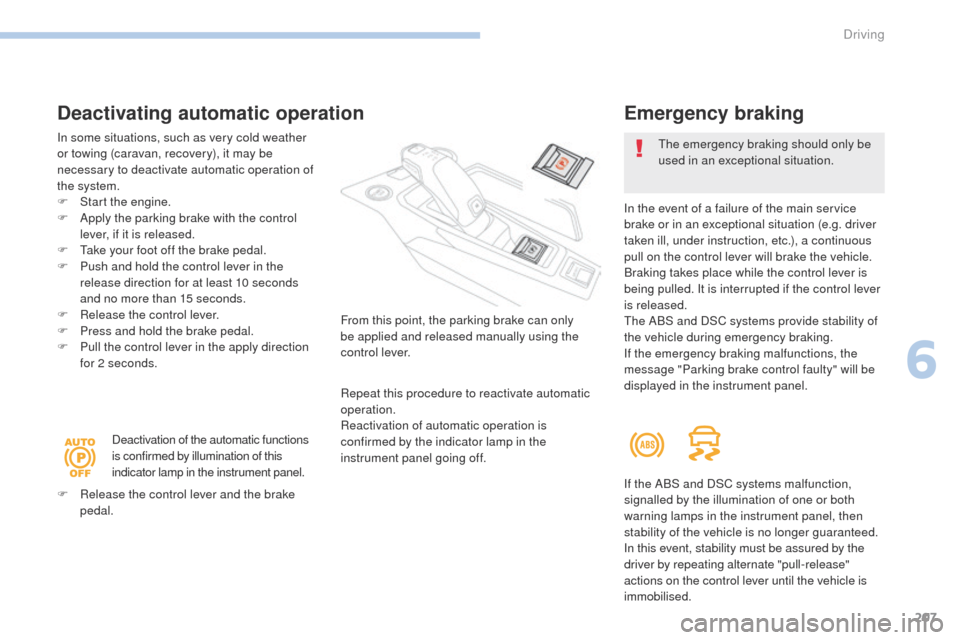
207
3008-2_en_Chap06_conduite_ed01-2016
Deactivating automatic operation
In some situations, such as very cold weather
or towing (caravan, recovery), it may be
necessary to deactivate automatic operation of
the system.
F
S
tart the engine.
F
A
pply the parking brake with the control
lever, if it is released.
F
T
ake your foot off the brake pedal.
F
P
ush and hold the control lever in the
release direction for at least 10 seconds
and no more than 15 seconds.
F
R
elease the control lever.
F
P
ress and hold the brake pedal.
F
P
ull the control lever in the apply direction
for 2 seconds.
Deactivation of the automatic functions
is confirmed by illumination of this
indicator lamp in the instrument panel.
F
R
elease the control lever and the brake
pedal. From this point, the parking brake can only
be applied and released manually using the
control lever.
Repeat this procedure to reactivate automatic
operation.
Reactivation of automatic operation is
confirmed by the indicator lamp in the
instrument panel going off.
Emergency braking
The emergency braking should only be
used in an exceptional situation.
In the event of a failure of the main service
brake or in an exceptional situation (e.g. driver
taken ill, under instruction, etc.), a continuous
pull on the control lever will brake the vehicle.
Braking takes place while the control lever is
being pulled. It is interrupted if the control lever
is released.
The ABS and DSC systems provide stability of
the vehicle during emergency braking.
If the emergency braking malfunctions, the
message "Parking brake control faulty" will be
displayed in the instrument panel.
If the ABS and DSC systems malfunction,
signalled by the illumination of one or both
warning lamps in the instrument panel, then
stability of the vehicle is no longer guaranteed.
In this event, stability must be assured by the
driver by repeating alternate "pull-release"
actions on the control lever until the vehicle is
immobilised.
6
Driving
Page 241 of 566
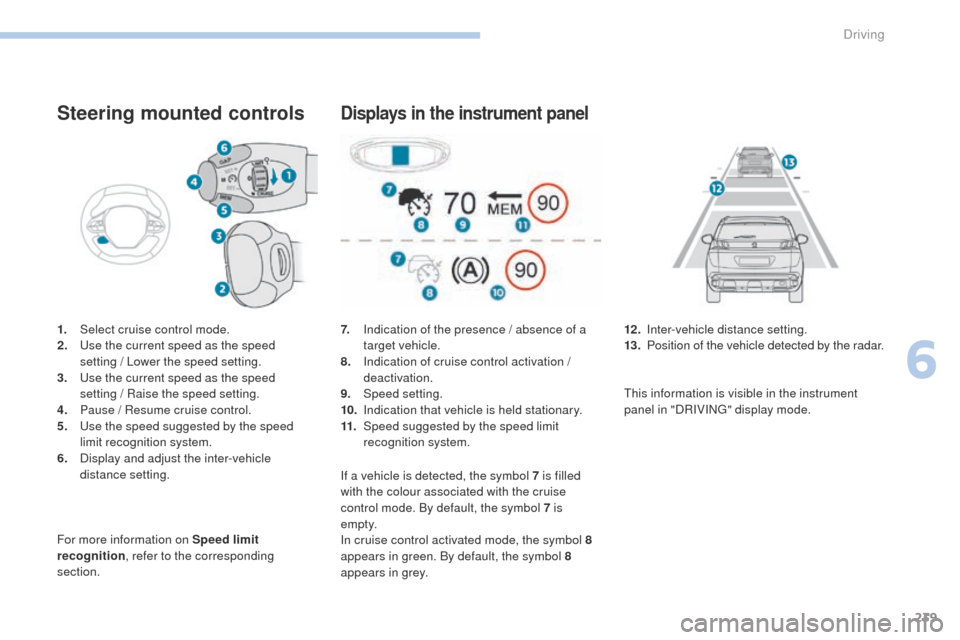
239
3008-2_en_Chap06_conduite_ed01-2016
Steering mounted controls
1. Select cruise control mode.
2. Use the current speed as the speed
setting
/ Lower the speed setting.
3.
U
se the current speed as the speed
setting
/ Raise the speed setting.
4.
P
ause / Resume cruise control.
5.
U
se the speed suggested by the speed
limit recognition system.
6.
D
isplay and adjust the inter-vehicle
distance setting.
For more information on Speed limit
recognition , refer to the corresponding
section.
Displays in the instrument panel
7. Indication of the presence / absence of a target vehicle.
8.
I
ndication of cruise control activation /
deactivation.
9.
Spe
ed setting.
10.
I
ndication that vehicle is held stationary.
11.
Spe
ed suggested by the speed limit
recognition system. 12 . I
nter-vehicle distance setting.
13. P osition of the vehicle detected by the radar.
If a vehicle is detected, the symbol 7
is filled
with the colour associated with the cruise
control mode. By default, the symbol 7 is
e m pt y.
In cruise control activated mode, the symbol
8
appears in green. By default, the symbol 8
appears in grey. This information is visible in the instrument
panel in "DRIVING" display mode.
6
Driving
Page 255 of 566
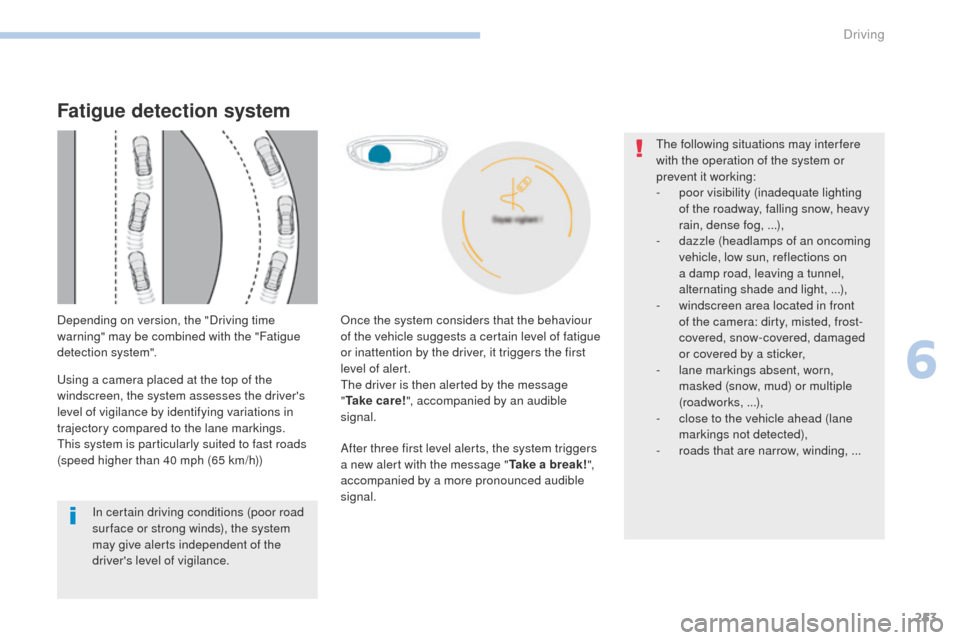
253
3008-2_en_Chap06_conduite_ed01-2016
After three first level alerts, the system triggers
a new alert with the message "Take a break!",
accompanied by a more pronounced audible
signal.
In certain driving conditions (poor road
sur face or strong winds), the system
may give alerts independent of the
driver's level of vigilance. The following situations may inter fere
with the operation of the system or
prevent it working:
-
p
oor visibility (inadequate lighting
of the roadway, falling snow, heavy
rain, dense fog, ...),
-
d
azzle (headlamps of an oncoming
vehicle, low sun, reflections on
a damp road, leaving a tunnel,
alternating shade and light, ...),
-
w
indscreen area located in front
of the camera: dirty, misted, frost-
covered, snow-covered, damaged
or covered by a sticker,
-
l
ane markings absent, worn,
masked (snow, mud) or multiple
(roadworks, ...),
-
c
lose to the vehicle ahead (lane
markings not detected),
- r oads that are narrow, winding, ...
Once the system considers that the behaviour
of the vehicle suggests a certain level of fatigue
or inattention by the driver, it triggers the first
level of alert.
The driver is then alerted by the message
"
Ta k e c a r e ! ", accompanied by an audible
signal.
Fatigue detection system
Depending on version, the "Driving time
warning" may be combined with the "Fatigue
detection system".
Using a camera placed at the top of the
windscreen, the system assesses the driver's
level of vigilance by identifying variations in
trajectory compared to the lane markings.
This system is particularly suited to fast roads
(speed higher than 40 mph (65 km/h))
6
Driving
Page 260 of 566

258
3008-2_en_Chap06_conduite_ed01-2016
Limits of operation
The system goes into standby automatically in
the following cases:
-
E
SC deactivated or operation triggered,
-
s
peed below 40 mph (65 km/h) or above
112 mph (180 km/h),
-
c
onnected electrically to a trailer,
-
u
se of the "space-saver" spare
wheel detected (as detection is not
immediate, deactivation of the system is
recommended),
-
d
ynamic driving style detected, pressure
on the brake or accelerator pedal,
-
d
riving where there are no lane markings,
-
ope
ration of the direction indicators,
-
d
riving in a tight corner,
-
i
nactivity by the driver detected during
correction. The system may not operate correctly
or at all in the following situations:
-
c
onditions of poor visibility
(inadequate street lighting,
snowfall, rain, fog),
-
d
azzle (headlamps of on oncoming
vehicle, low sun, reflections on a
wet road sur face, leaving a tunnel,
alternating light and shade),
-
a
rea of the windscreen in front of
the camera dirty, misted, frosted,
snow-covered, damaged or
covered by a sticker,
-
r
oad markings absent, worn,
hidden (snow, mud) or multiple
(roadworks),
-
r
unning close to the vehicle in front
(the lane markings may not be
detected),
-
n
arrow, twisty roads.Risk of undesirable operation
Deactivation of the system is recommended in
the following situations:
-
d
riving on a road sur face in poor condition,
-
u
nfavorable weather conditions,
-
d
riving on slippery sur faces (black ice).
The system is not designed for the following
driving situations:
-
d
riving on a speed circuit,
-
d
riving with a trailer,
-
d
riving on a rolling road,
-
d
riving on unstable sur faces.
Driving
Page 339 of 566
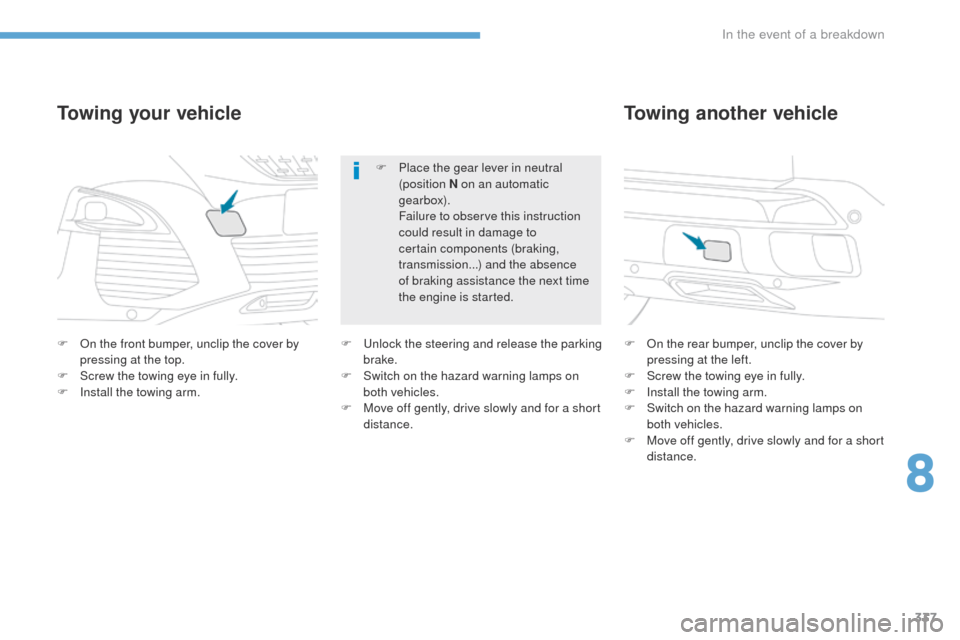
337
3008-2_en_Chap08_en cas-de-panne_ed01-2016
F On the front bumper, unclip the cover by pressing at the top.
F
S
crew the towing eye in fully.
F
I
nstall the towing arm.
Towing your vehicle
F On the rear bumper, unclip the cover by pressing at the left.
F
S
crew the towing eye in fully.
F
I
nstall the towing arm.
F
S
witch on the hazard warning lamps on
both vehicles.
F
M
ove off gently, drive slowly and for a short
distance.
Towing another vehicle
F Unlock the steering and release the parking brake.
F
S
witch on the hazard warning lamps on
both vehicles.
F
M
ove off gently, drive slowly and for a short
distance. F
P
lace the gear lever in neutral
(position N on an automatic
gearbox).
F
ailure to observe this instruction
could result in damage to
certain components (braking,
transmission...) and the absence
of braking assistance the next time
the engine is started.
8
In the event of a breakdown
Page 348 of 566

346
3008-2_en_Chap11_index-alpha_ed01-2016
180° rear vision .............................................2 67Air intake .......................................................111
Air vents ........................................................104
Alarm
...............................................................70
Amplifier, audio
.............................................12 2
Anti-lock braking system (ABS)
......................................16
0, 161
Anti-theft
.......................................................197
Armrest, front
................................................124
Armrest, rear
................................................. 13
4
Assistance call
..............................................15 8
Assistance, emergency braking
...............
.................................160, 249
Audio system (r adi o)
............................................................45
C
Capacity, fuel tank .............................. ..........281
Cartridge, fragrance .............................125, 126
Central locking
.......................................... 60, 68
Changing a bulb
........................... 323, 328 , 330
Changing a fuse
............................................ 331
Changing a wheel
......................................... 309
Changing a wiper blade
................................15 4
Changing the remote control battery
........................................................... 66
C
harger, induction
......................................... 12 2
Charger, wireless
.......................................... 12 2
CHECK
................
............................................ 40
Checking the engine oil level
.......................................................... 36
Checking the levels
...............................2 97- 3 0 0
Checking tyre pressures (using the kit)
..............................
................312
Checks
...............
..................295, 296 , 301, 302
Checks, routine
..................................... 301, 302
Child lock
...............................
................193, 19 4
Children
...............................
..18 4 , 18 6 -188 , 19 0
Children (safety)
...............................
.....193 , 19 4
Backrest, folding
............................................. 92
Battery
................................... 290, 301 , 332-335
Battery, charging
........................................... 334
Battery, remote control
............................. 63,
66
Blanking screen
(snow shield)
...............................
................ 291
Blind
................................................................ 84
Blind spot monitoring system
......... 20, 260 , 262
Blind spot monitoring system, active ..................................................... 20, 262
Blind spot sensors
.................................. 20, 260
BlueHDi
..................................... 37, 40 , 303 , 308
Bonnet
........................................................... 294
Boot
..................................................... 75, 76 , 79
Brake discs
.................................................... 3
02
Brake lamps
.................................................. 328
B
Brakes ..................................................... 26, 302
Braking assistance system
......................................................... 160
Braking, automatic emergency
.............................. 21, 26 , 247 , 250
Braking, dynamic emergency
......................................... 203, 208
Bulbs (changing)
.......................... 32
3, 328 , 330
Accessories
.......................................... 15 6, 201
Active Safety Brake................... 21, 26 , 247 , 250
AdBlue
® ..................................... 3 0, 37 , 303 , 304
Additive, Diesel ............................................. 301
Adjusting headlamps
.................................... 145
Adjusting head restraints
................................ 93
Adjusting seat
..................................... 90, 91 , 94
Adjusting the air distribution
.........................111
Adjusting the air flow
..................................... 111
Adjusting the date
........................................... 45
Adjusting the height and reach of the steering wheel
.................................... 99
Adjusting the lumbar support
..............90, 91 , 94
Adjusting the seat belt height
.......................168
Adjusting the temperature
............................ 111
A
djusting the time
........................................... 45
Advanced Grip Control
................................. 16 4
Advice on driving
.................................. 195, 19 6
Airbags
.................................................... 28, 172
Airbags, curtain
..................................... 17
5, 176
Airbags, front ......................................... 173, 176
Airbags, lateral
...................................... 175, 176
Air conditioning
................................ 10, 107 , 11 0
Air conditioning, automatic
...........................105
Air conditioning, digital
.......................... 111, 11 6
Air conditioning, dual-zone automatic
............................................. 111,
11 6
Air conditioning, manual
...............105, 10 6 , 11 6
Air conditioning, mono-zone
.................108, 11 6
A
Alphabetical index
Page 452 of 566
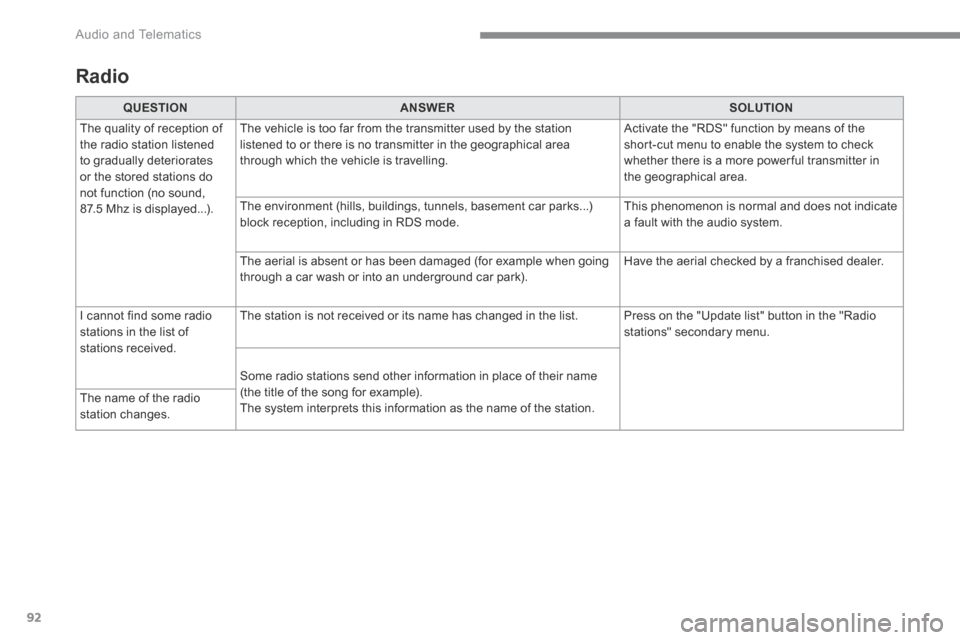
92
Audio and Telematics
Transversal-Peugeot_en_Chap01_NAC-2-2-0_ed01-2016
Radio
QUESTIONANSWERSOLUTION
The quality of reception of the radio station listened to gradually deteriorates or the stored stations do not function (no sound, 87.5 Mhz is displayed...).
The vehicle is too far from the transmitter used by the station listened to or there is no transmitter in the geographical area through which the vehicle is travelling.
Activate the "RDS" function by means of the short-cut menu to enable the system to check whether there is a more power ful transmitter in the geographical area.
The environment (hills, buildings, tunnels, basement car parks...) block reception, including in RDS mode. This phenomenon is normal and does not indicate a fault with the audio system.
The aerial is absent or has been damaged (for example when going through a car wash or into an underground car park). Have the aerial checked by a franchised dealer.
I cannot find some radio stations in the list of stations received.
The station is not received or its name has changed in the list. Press on the "Update list" button in the "Radio stations" secondary menu.
Some radio stations send other information in place of their name (the title of the song for example). The system interprets this information as the name of the station. The name of the radio station changes.
Page 509 of 566
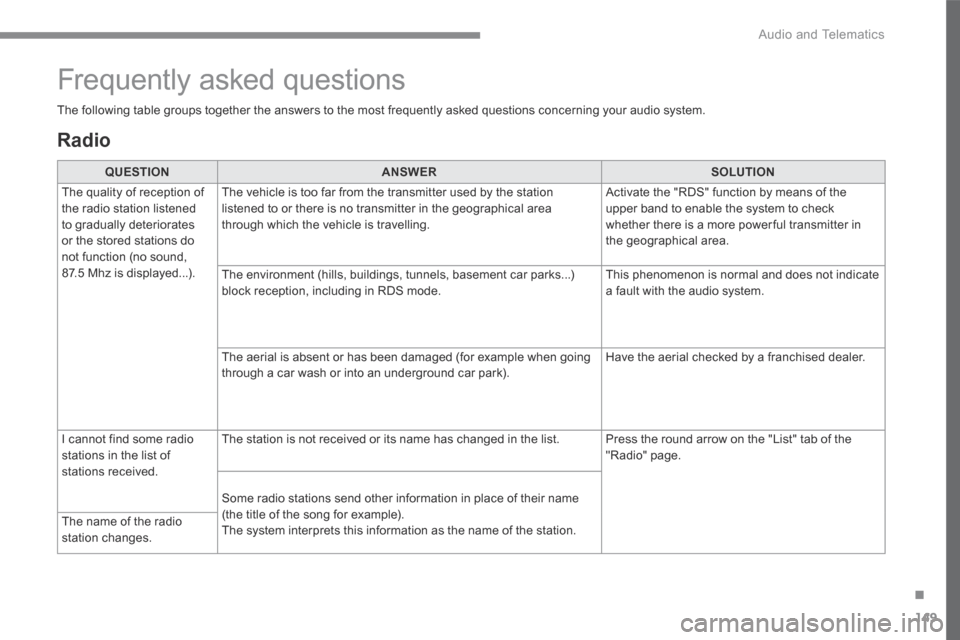
149
.
Audio and Telematics
Transversal-Peugeot_en_Chap02_RCC-2-2-0_ed01-2016
Radio
QUESTIONANSWERSOLUTION
The quality of reception of the radio station listened to gradually deteriorates or the stored stations do not function (no sound, 87.5 Mhz is displayed...).
The vehicle is too far from the transmitter used by the station listened to or there is no transmitter in the geographical area through which the vehicle is travelling.
Activate the "RDS" function by means of the upper band to enable the system to check whether there is a more power ful transmitter in the geographical area.
The environment (hills, buildings, tunnels, basement car parks...) block reception, including in RDS mode. This phenomenon is normal and does not indicate a fault with the audio system.
The aerial is absent or has been damaged (for example when going through a car wash or into an underground car park). Have the aerial checked by a franchised dealer.
I cannot find some radio stations in the list of stations received.
The station is not received or its name has changed in the list. Press the round arrow on the "List" tab of the "Radio" page.
Some radio stations send other information in place of their name (the title of the song for example). The system interprets this information as the name of the station. The name of the radio station changes.
Frequently asked questions
The following table groups together the answers to the most frequently asked questions concerning your audio system.